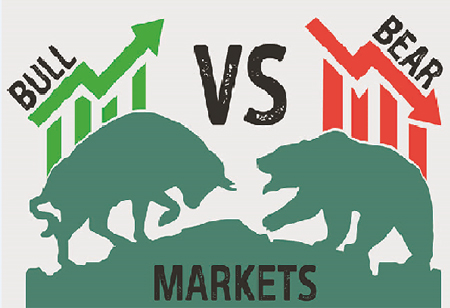What Can Bull and Bear Mean to Your Business
By Aveek Pal Chaudhuri
 The terms “Bull” and “Bear” are common in the investing world. These terms signify market conditions. As the path covered by any market affects a business’s reign, familiarity with the terms is highly essential to learn about the functionality of “Bull” and “Bear” in the business coordinates.
The terms “Bull” and “Bear” are common in the investing world. These terms signify market conditions. As the path covered by any market affects a business’s reign, familiarity with the terms is highly essential to learn about the functionality of “Bull” and “Bear” in the business coordinates.
Each has its own definition. The market which is economically developed and witness growth with time is a Bull market and the market where the economic conditions are traumatized due to declining stock values is known as a Bear market. Stock market, in general, has obstacle-free return for the investors; without hesitation it is duly conclusive that the Bull market population outbalances the Bear market population. This is why investors often step back from investing in a bear market. A major section of the investors face loss in equity with share prices dropping like a sudden avalanche.
On the contrary, the Bull market marks the gradual upsurge in price that is why businesses do not find any trouble in spending in the Bull market. A country resting its economy on the Bull market achieves a stronger economy and higher employment rate when compared to any other.
A market cycle is measured from the highest point to lowest. When a stock index extends towards the Bear territory during which the closing price falls by 20 percent as compared to its most significant high, it is known as watch for 20 percent. On reverse, the start of the new Bull market is notified when the closing price from its low attains a 20 percent profit. The present Bull market has perceived a 330 percent S&P rise in the past 10 years. Though it resides at the second position as the 90s Bull market gave 417 percent in return.
Because the Bull and Bear market complements each other, an American-British investor John Templeton said, “There will always be Bull markets followed by Bear markets followed by Bull markets.” This is why, the Founder of Davis Selected Advisers, Shelby Davis advised on the Bull and Bear market by saying, “Invest for the long haul. Don’t get too greedy and don’t get too scared.”
Factors to Consider Before Investing
- Supply and Security Demand – You will come across strong demand and weak supply in a Bull market as most of the investors have wishes of buying and a few of them have urges of selling. This results into share price rising where investors fight for obtaining the unsold equity.In the case of a Bear market, it is quite the opposite. The sellers are major in number selling to only a handful of buyers. Here, the demand is low than supply and share prices fall usually.
- Understanding The Mind Of An Investor – The investors’ emotions have a huge effect on the markets’ growth and collapse. It can be said that the stock market display and an investor’s thinking are correlated. You will find investors participating in the Bull market without any hesitation for gaining profit. Since a Bear market outbreak which carries undesirable sentiments, the investors start moving cash out from equities and put it into income-generating assets while waiting for regrowth of the market.
- Economic Vibrations – There are businesses that depend on exchanges for stock trading where the investors are from the greater economy. A bear market is linked to the weaker economy where a maximum number of businesses is devoid of making huge profits as consumers spend very negligible amounts or they do not even spend any. Consequently, economic vibrations fall changing the stock market values to lower in number. But in a Bull market, there are people as many in a full packed theater, who spend willingly for strengthening the economic structure.
A country whose GDP is high has a Bull market and a Bear market is full of loss of jobs and economic insecurities. It is wise to judge the local market before investing with dreams of getting high returns.




